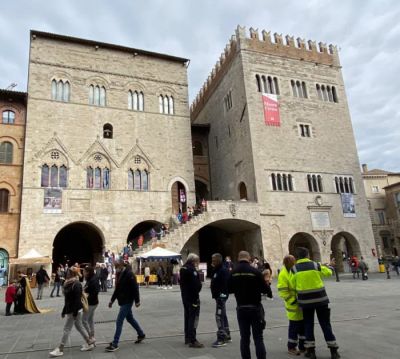L’articolo parla del Duomo di Todi in Piazza del Popolo in un piccolo paese dell'Umbria. Questo paese è ricco di storia e di statue antiche. La scrittrice descrive il Palazzo dei Priori, costruito nel 14o secolo ed i sei rioni che si trovano alle finestre. Descrive, anche, il Palazzo del Capitano del Popolo che si trova in Piazza del Popolo. Il Palazzo è conosciuto per lo stemma sopra le finestre ed anche la Sala delle Pietre. La scrittrice suggerisce un viaggio in Umbria per vedere questa piazza soprattutto nel mese di ottobre quando la città festeggia il santo patrono, San Fortunato. Per informazioni, visita il sito web a fine dell’articolo.
When you step out of Todi’s Duomo, the Piazza del Popolo spreads out before you like a medieval stage set. The Umbrian hilltop town is home to medieval buildings and artwork.
Opposite the town’s Duomo is the primary seat of civic power, the mid-14th century Palazzo dei Priori, where the civic magistrates, i priori, governed in the Middle Ages and some of Todi’s city officials have their offices today. The palazzo is crowned with battlements representing the Guelfs, those aligning with Papal power in the Middle Ages and the trapezoidal tower was added in the mid-14th century.
In October, during the celebrations of the patron saint, San Fortunato, the banners of the six rioni (districts or neighborhoods) are draped from the windows just below the mid-14th century symbol of Todi, a bronze eagle, wings outspread (fig.1). The eagle is the protagonist in Todi’s coat-of-arms and grasps a tablecloth in its claws, linked to the founding of Todi in an ancient legend. In the Middle Ages, Todi’s three elected priori lived and worked in this palazzo during their six months in office.
To the left of the Palazzo dei Priori, a pair of majestic civic palazzi flank Todi’s main square, the Piazza del Popolo (fig. 2). Just behind the stairs, the Palazzo del Capitano del Popolo (Palace of the Captain of the People, the official maintaining public order in the Middle Ages), built in 1240, rises above an impressive, vaulted portico. Bringing light into the building are three elegant mullioned Gothic windows of medieval Venetian style.
Reliefs of coats-of-arms are sculpted in limestone above and below the windows. The stairs lead to the spacious Sala del Capitano embellished with 14th century frescoes, where the Capitano once presided over gatherings.
The civic palace next door, the Palazzo del Popolo, was built in Gothic-Lombard style in 1213 on low porticoes and is graced at the top by battlements in the Ghibelline style. The red banner draped below the upper windows indicates the location of Todi’s Museo Civico (fig.3).
The room behind the green banner is la Sala delle Pietre (“Hall of Stones”). This vast room was significantly restored in 2016 and is now Todi’s most prestigious site for shows and expositions (fig.4). A series of additions and restorations had changed the structure of the palazzo since the 14th century. Fragments of frescoes decorate the walls including the coat-of-arms of the mid-13th century podesta (mayor) Savelli who had commissioned the work on the palazzo. From the late 17th century until the late 19th century, the ambience hosted the teatro. Major restoration work was undertaken in the very early 20th century and, at that time, the notable lapidary collection (a collection of stones, minerals and gemstones), started in the 17th century, of the city of Todi was displayed here. Hence, the name of the room.
Many contemporary artists now fill the space of the Hall of Stones with their exhibitions. On your next trip to Umbria, add Todi to your list of sites to see.
For more information on Umbria and its surrounding areas, visit www.annesitaly.com and www.stayassisi.com.
https://www.lagazzettaitaliana.com/travel/10067-todi-s-piazza-del-popolo#sigProIda72a6e6790




